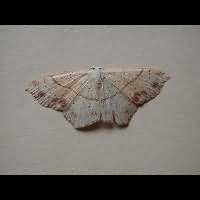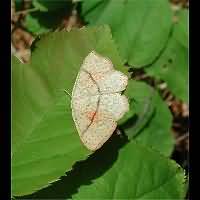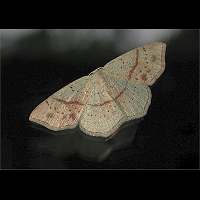Maiden's Blush Moth (Cyclophora punctaria)
The Maiden's Blush Moth doesn't always show her blush. Usually it is better visible in the summer generation. The spring generation normally is paler and less clearly marked. The ground colour of the wings is a beige white to ocher. There is one dark line, usually red or brown, running over both wings. Above and below this dark line run lines of grey dots. Near the lower edge of the front wing are the red or reddish blushes. Each specimen has these in a different size and intensity of colour. In some cases both the line and the blushes are grey. One of the dotted lines may also have disappeared, or they are both absent. Legs and antennae are white to beige. The wingspan varies from 25 to 32 mm.
Cyclophora punctaria's larvae are extremely variable and may be greyish, greenish or brown. Usually the spots on the sides give it away: near the brown lines waving over the body are red with yellow spots. The caterpillar will reach a length of some 23 mm. In autumn the larva attaches itself to a leaf: it spins a thread, raps it around his body at just one spot and attaches this gurdle to the leaf. It falls down together with the leaf and stays attached until next spring, when it crawls back into the tree. Pupation takes place by attaching the pupa to a leaf the same way. Sometimes birch is mentioned as a host plant, but it is pretty certain that the caterpillars live exclusively on oak.
The Maiden's Blush Moth flies in two generations and is about for quite some time, usually from late April to the beginning of September, clearly peaking in May and August. Flies about from dusk onwards. It is sometimes attracted by light, but never in great numbers. During the day seen resting on leaves of shrubs or trees. This species is always a local one, but when it is present it may appear in great numbers. Prefers light forests on sandy soils. Widely spread throughout most of England and Wales. Less frequent in Northern England and Scotland. Also a resident of Ireland, but only found locally, especially in the west. In other parts of Europe a widely spread species, sometimes very common, on sandy soils.
The Maiden's Blush Moth doesn't always show her blush. Usually it is better visible in the summer generation. The spring generation normally is paler and less clearly marked. The ground colour of the wings is a beige white to ocher. There is one dark line, usually red or brown, running over both wings. Above and below this dark line run lines of grey dots. Near the lower edge of the front wing are the red or reddish blushes. Each specimen has these in a different size and intensity of colour. In some cases both the line and the blushes are grey. One of the dotted lines may also have disappeared, or they are both absent. Legs and antennae are white to beige. The wingspan varies from 25 to 32 mm.
Cyclophora punctaria's larvae are extremely variable and may be greyish, greenish or brown. Usually the spots on the sides give it away: near the brown lines waving over the body are red with yellow spots. The caterpillar will reach a length of some 23 mm. In autumn the larva attaches itself to a leaf: it spins a thread, raps it around his body at just one spot and attaches this gurdle to the leaf. It falls down together with the leaf and stays attached until next spring, when it crawls back into the tree. Pupation takes place by attaching the pupa to a leaf the same way. Sometimes birch is mentioned as a host plant, but it is pretty certain that the caterpillars live exclusively on oak.
The Maiden's Blush Moth flies in two generations and is about for quite some time, usually from late April to the beginning of September, clearly peaking in May and August. Flies about from dusk onwards. It is sometimes attracted by light, but never in great numbers. During the day seen resting on leaves of shrubs or trees. This species is always a local one, but when it is present it may appear in great numbers. Prefers light forests on sandy soils. Widely spread throughout most of England and Wales. Less frequent in Northern England and Scotland. Also a resident of Ireland, but only found locally, especially in the west. In other parts of Europe a widely spread species, sometimes very common, on sandy soils.









